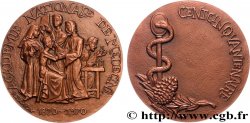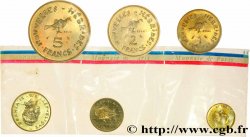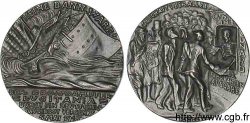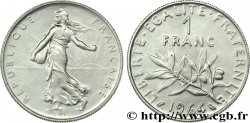MONNAIES 30 (2007)
起拍价 : 250.00 €
估价 : 1 000.00 €
竞价记录 : 290.00 €
出价数量 : 2
最高出价 : 500.00 €
起拍价 : 250.00 €
估价 : 1 000.00 €
竞价记录 : 290.00 €
出价数量 : 2
最高出价 : 500.00 €
种类 1 franc Semeuse, nickel, frappe sur métal fritté
日期: 1964
铸币厂名称/城市 Paris
铸币数量 ---
材质 nickel
直径 24,02 mm
模子方针 6 h.
重量 5,85 g.
侧面 striée
稀少度 UNIQUE
关于品相的说明
Infimes petits chocs visibles à la loupe, frappe avec des coins neufs, sans velours
正面
正面的文字 REPUBLIQUE FRANÇAISE..
正面的说明书 La République à gauche, sous les traits d'une semeuse drapée et coiffée d'un bonnet phrygien, aux cheveux longs, marchant et semant à contre-vent ; en arrière-plan, derrière la semeuse à droite, un soleil levant ; au-dessous, en creux O. ROTY.
背面
背面的文字 LIBERTE. EGALITE. FRATERNITE..
背面的说明书 1 / FRANC, en deux lignes au-dessus d'une branche d'olivier tournée à gauche; au-dessous, 1964 encadré des différents.
评论
Nous avions remarqué que cet exemplaire avait un poids curieusement faible et nous nous demandions si, compte tenu de sa présence dans cette collection, il ne correspondait pas à une frappe particulière. Nous avions remarqué qu’il était contenu dans une pochette de plastique cristal au nom de la Monnaie de Paris avec deux annotations manuscrites “1 F fritté” (??) et, peut-être, 17 oct.
C’est Daniel Kalfon qui a trouvé la clé de l’énigme : “le métal fritté a été mis au point au Canada pour remplacer l'acier traditionnel, il s'agirait d'un agglomérat de poudres métalliques.
L'aspect de la pièce parait plus mou, comme moulé et l’indication “fritté” confirme (comme le poids faible) : c'est bien un travail d'atelier, certainement destiné à essayer un nouveau support métallique.”
Nous sommes donc en présence d’un essai de métal, ou plus exactement de texture de métal, dans l’état actuel de nos connaissances unique, manifestement frappé le 17 octobre 1964. Il est exact que l’aspect du produit fini n’est guère agréable par rapport à une frappe normale sur métal laminé et embouti pour former des flans.
Bien entendu, la monnaie est vendue avec la pochette.
We had noticed that this specimen had a curiously low weight and we wondered if, given its presence in this collection, it did not correspond to a particular strike. We noticed that it was contained in a crystal plastic sleeve in the name of the Monnaie de Paris with two handwritten annotations “1 F fritté” (??) and, perhaps, 17 Oct.
It was Daniel Kalfon who found the key to the enigma: “sintered metal was developed in Canada to replace traditional steel; it is an agglomerate of metal powders..
The appearance of the piece seems softer, as if molded, and the “sintered” indication confirms this (like the low weight): it is indeed a workshop job, certainly intended to test a new metal support.. \\\"We are therefore in the presence of a test of metal, or more precisely of metal texture, in the current state of our knowledge unique, clearly struck on October 17, 1964. It is true that the appearance of the finished product is not very pleasant compared to a normal strike on rolled and stamped metal to form blanks..
Of course, the coin is sold with the pouch.
C’est Daniel Kalfon qui a trouvé la clé de l’énigme : “le métal fritté a été mis au point au Canada pour remplacer l'acier traditionnel, il s'agirait d'un agglomérat de poudres métalliques.
L'aspect de la pièce parait plus mou, comme moulé et l’indication “fritté” confirme (comme le poids faible) : c'est bien un travail d'atelier, certainement destiné à essayer un nouveau support métallique.”
Nous sommes donc en présence d’un essai de métal, ou plus exactement de texture de métal, dans l’état actuel de nos connaissances unique, manifestement frappé le 17 octobre 1964. Il est exact que l’aspect du produit fini n’est guère agréable par rapport à une frappe normale sur métal laminé et embouti pour former des flans.
Bien entendu, la monnaie est vendue avec la pochette.
We had noticed that this specimen had a curiously low weight and we wondered if, given its presence in this collection, it did not correspond to a particular strike. We noticed that it was contained in a crystal plastic sleeve in the name of the Monnaie de Paris with two handwritten annotations “1 F fritté” (??) and, perhaps, 17 Oct.
It was Daniel Kalfon who found the key to the enigma: “sintered metal was developed in Canada to replace traditional steel; it is an agglomerate of metal powders..
The appearance of the piece seems softer, as if molded, and the “sintered” indication confirms this (like the low weight): it is indeed a workshop job, certainly intended to test a new metal support.. \\\"We are therefore in the presence of a test of metal, or more precisely of metal texture, in the current state of our knowledge unique, clearly struck on October 17, 1964. It is true that the appearance of the finished product is not very pleasant compared to a normal strike on rolled and stamped metal to form blanks..
Of course, the coin is sold with the pouch.








 对产品描述纠错
对产品描述纠错 打印
打印 分享我的选择
分享我的选择 提问
提问 Consign / sell
Consign / sell
 产品介绍
产品介绍















